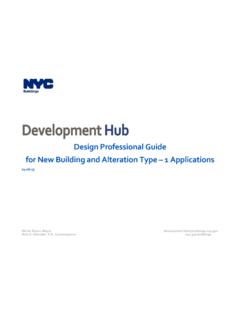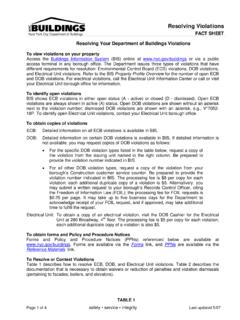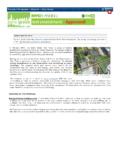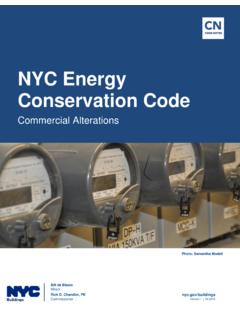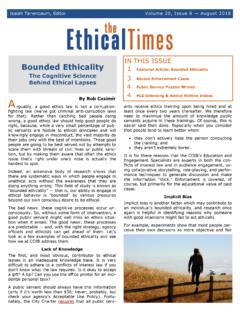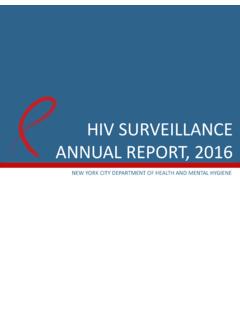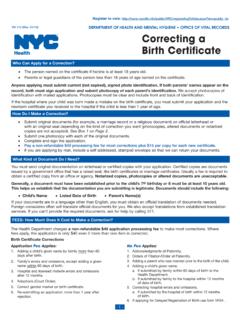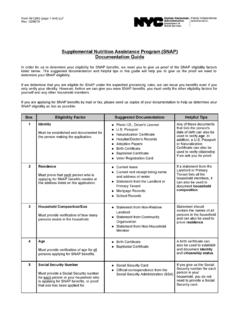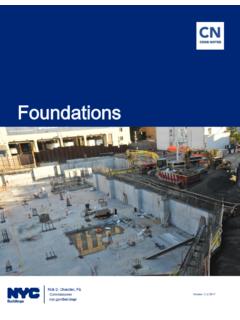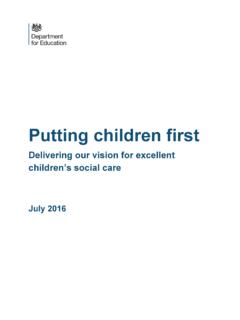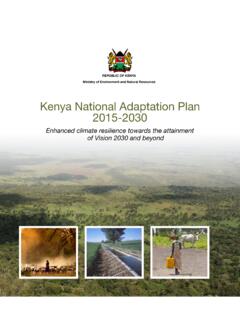Transcription of Climate Resiliency Design uielines - ersion 3.0 Recover y ...
1 NYC Mayor's Office of Recovery and Resiliency Climate Resiliency Design Guidelines - Version Recovery and Resiliency Climate Resiliency Design Guidelines March 2019. Version 1. NYC Mayor's Office of Recovery and Resiliency Climate Resiliency Design Guidelines - Version this page intentionally left blank 2. NYC Mayor's Office of Recovery and Resiliency Climate Resiliency Design Guidelines - Version Contents I. A. Climate Change in New York B. Useful Life of Capital C. Defining Critical Facilities and Major Facilities ..8. D. Managing E. Project-specific II. Resilient A. Increasing B. Increasing C. Sea Level III. A. Resilient Design B. Exposure Screening C. Risk Assessment D. Benefit-cost Analysis Appendices 1. Key 2. Climate Change 3. Differentiation of Flood 4. Design Strategies 5. Project Benefit Works Cover photo by the New York City Department of Environmental Protection 3. DRAFT & CONFIDENTIAL. NYC Mayor's Office of Recovery and Resiliency Climate Resiliency Design Guidelines - Version this page intentionally left blank 4.
2 NYC Mayor's Office of Recovery and Resiliency Climate Resiliency Design Guidelines - Version I. Introduction In the coming years and throughout the 21st century, New York City (NYC) will face new challenges from a rapidly changing Climate . Many capital projects, including infrastructure, landscapes, and buildings ( facilities ), will experience extreme flooding, precipitation, and heat At the same time, the region's environmental conditions are also projected to change, posing chronic hazards as some coastal areas are regularly inundated by high tide and average annual temperatures rise. In NYC's Roadmap to 80 x 50, the City of New York (the City) committed to reducing emissions of greenhouse gases by 80% by While the City is working toward a low carbon future, the impacts from Climate change are already occurring, and these Guidelines establish how the City can increase the Resiliency of its facilities to unavoidable Climate change hazards through Design .
3 The Climate Resiliency Design Guidelines ( the Guidelines ) provide step- by-step instructions on how to supplement historic Climate data with specific, The Guidelines regional, forward-looking Climate change data in the Design of City facilities. provide step-by- Resilient Design is intended to become an integral part of the project planning step instructions on process for City agencies and designers. All new projects and substantial improvements should assess risks to Climate change hazards in the context of how to supplement the project's purpose, asset type, site location, and funding, and then determine historic Climate data the appropriate resilient Design strategies using the Guidelines. The Guidelines with specific, regional, apply to all City capital projects except coastal protection projects ( sea walls, bulkheads, and levees), for which the City is developing separate guidance. forward-looking Climate Implementing the Guidelines will result in designs that will make City facilities change data in the more resilient to Climate change and promote the health, safety, and prosperity of New Yorkers.
4 Design of City facilities. The primary goal of the Guidelines is to incorporate forward-looking Climate change data in the Design of all City capital projects. Codes and standards that regulate the Design of facilities already incorporate historic weather data to determine how to Design for today's conditions. However, historic data does not accurately represent the projected severity and frequency of future storms, sea level rise, heat waves, and precipitation. The Climate is already changing and will continue to change in significant ways over the full useful life of facilities designed today, threatening to undermine capital investments and impede critical services if they are not designed to future conditions. The Guidelines complement the use of historic data in existing codes and standards by providing a consistent methodology for engineers, architects, landscape architects, and planners to Design facilities that are resilient to changing Climate conditions (see Figure 1).
5 The Guidelines are to be used throughout the Design process during project planning initiation, as a reference in requests for proposals (RFPs), during a conceptual or study phase, through to final Design for all new construction and substantial improvements of City facilities. NPCC Climate change Historic weather data projections Building code and Climate Resiliency Design standards Design Guidelines Design of NYC capital projects Figure 1 - Both historic weather data and Climate change projections inform the Design of capital projects in NYC. 1. Though the intensity and frequency of storms is expected to increase, firm projections on future wind conditions have not yet been developed. NYC s undertaking a study to assess projected changes to extreme wind hazards and identify risks to the city's built environment. 2. To learn more about 80 x 50, visit: I. Introduction 5. NYC Mayor's Office of Recovery and Resiliency Climate Resiliency Design Guidelines - Version A successful Resiliency strategy is one that provides co-beneficial outcomes, reduces costs over the life of the asset wherever possible, and avoids negative indirect impacts to other systems.
6 Resilient Design should not exist in a silo, but rather be a well-integrated part of existing processes and address other goals of the City. For example, resilient Design choices should be made as an integral part of the City's project planning, risk management, and financial planning. Similarly, resilient Design choices should be selected to maximize the efficacy and efficiency of investments. Some ways this can be done include: 1) integrating soft Resiliency strategies (operational measures or investments in green infrastructure) and hard Resiliency strategies (built or intensive investments); 2) addressing multiple Climate hazards with single interventions; and 3) reducing Climate change risk in concert with other goals ( , energy efficiency or reduction in greenhouse gas emissions). These Guidelines were developed by the Mayor's Office of Recovery and Resiliency (ORR) in collaboration with City agencies developing and delivering capital projects.
7 The development of the Guidelines has been an iterative, and ongoing, process of testing, vetting, and improving. Important milestones in the development timeline include: Fall 2016: the Design Guidelines Working Group, which includes more than 15 City agencies, was convened to collaborate and advise on the development of the April 2017: the preliminary version ( ) of the Guidelines was issued. April 2017 - November 2018: the preliminary version of the Guidelines was tested through an extensive review with internal and external Climate and Design experts, and review of City capital projects. April 2018: version of the Guidelines was released with various improvements reflecting lessons learned, including the addition of a benefit-cost analysis methodology and projections on Cooling Degree Days and Dry Bulb temperatures. March 2019: version of the Guidelines was released with refinements, including an Exposure Screening Tool and a Risk Assessment Methodology.
8 B. Climate Change in New York City The New York City Panel on Climate Change (NPCC) provides regional Climate change projections that inform City Resiliency policy. Composed of leading scientists, the NPCC's projections for the metropolitan region show that extreme weather will increase in frequency and severity, and that the Climate will become more variable. These projections are divided across future time slices including the 2020s, 2050s, 2080s, and 2100. The 2015 NPCC Climate change projections (which were reassessed and validated in 2019) encompass a range of possible outcomes, for example: Mean annual temperature is projected to rise by to F by the 2050s, and by to F by the Frequency of heat waves is projected to triple by the 2050s to 5 to 7 heat waves per year and 5 to 8 heat waves per year by the Mean annual precipitation is projected to increase between 4 to 13% by the 2050s, and by 5 to 19% by the Sea level is expected to keep rising by 11 to 21 inches by the 2050s, and by 18 to 39 inches by the For more information on Climate change projections for the metropolitan region, see Appendix 2.
9 As the NPCC. continues to study and refine projections, the Guidelines will be updated as needed to reflect changes in the scientific consensus. 3. Representatives from the following City agencies contributed to the Guidelines: Environmental Protection, Transportation, City Planning, Buildings, Design and Construction, Parks and Recreation, Emergency Management, School Construction Authority, City Administrative Services, Health and Hospitals, Information Technology and Telecommunications, Economic Development Corporation, Housing Authority, Public Design Commission, Mayor's Office of Sustainability, Mayor's Office of the Chief Technology Officer, Housing Preservation and Development, Office of Management and Budget, Sanitation, and Law. 4. Ranges for heat reflect the middle and high range estimates from the NPCC. See Appendix 2 for more information. 5. Ibid. 6. Ranges for precipitation reflect the middle and high range estimates from the NPCC.
10 See Appendix 2 for more information. 7. Ranges for sea level rise reflect the middle range estimates from the NPCC. See Appendix 2 for more information. 6 I. Introduction NYC Mayor's Office of Recovery and Resiliency Climate Resiliency Design Guidelines - Version C. Useful Life of Capital Projects A resilient facility is one built to withstand, or Recover quickly from, natural hazards, as well as to perform to its Design standard throughout its useful life in a changing Climate . To meet this goal, facilities should be designed to withstand Climate conditions projected for the end of the facility's useful Full useful life represents the extended service life of a facility (assuming regular maintenance). Some new facilities built today, including some buildings, may have an extended useful life beyond the values listed after undergoing substantial improvements. Therefore, this list is illustrative and not exhaustive.
